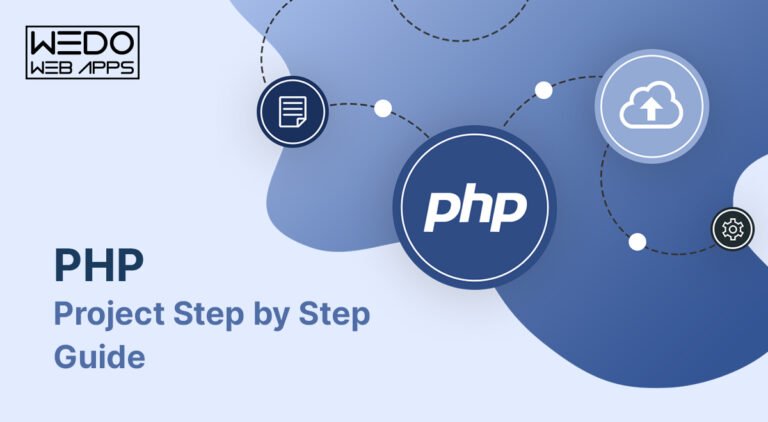26 Jul, 2023 | Web Development Company
Php Project Step by Step All About Building Your Web Presence with PHP

Topics covered in this blog:
- PHP project: Step by step - PHP Website Directory & File Structure -About PHP Website Folder Structure -About PHP Website File Structure -The factors to consider while choosing the PHP version -PHP Functionalities: Cookies & Redirects Businesses choose PHP development agencies like ours to harness the power of PHP development at its maximum. We will talk in detail about the essential elements involved in a PHP project in the blog.php project step by step
PHP project step by step -
For a successful outcome of a PHP project, a systematic approach is required. Let's learn about a PHP project, step by step. Step 1: Gathering Requirement: Streamlining the accurate details about the client's needs, aim, and target audience plays a very important part to start the project. Step 2: Strategising & Assessment: In this phase, a detailed project plan is curated, milestones are defined, technical specifications are figured out and functionalities are outlined. Step 3: Visual Prototype Framing: In this step, the project's design elements are accurately planned to create a refined visual representation of the website's structure and user interface. Step 4: Integration & Database Design: This is a crucial aspect of the project, where an efficient data architecture is developed and integrated with the PHP code. Step 5: Coding & Development: This step is where the actual coding is done. Skilled PHP developers excel in the art of writing clean, unproblematic, straightforward, and maintainable codes while integrating practical functionality and components based on the project requirements. Step 6: Testing & Quality Security: After the above steps, comes the testing phase, which ensures the smooth, bug-free working of the website, and an outstanding user experience across various devices and browsers. Thorough testing is done to ensure the same. Step 7: Maintenance & Implementation: Once the rigorous testing is done, the deployment of the website is done to a server with ongoing maintenance that ensures its proper performance, security & updates. Understanding the PHP project step by step is crucial for an impactful project & achieving the desired look & feel.PHP Website Directory & File Structure
Let's talk about the PHP website directory structure, which plays a very important role in organizing the PHP website effectively & efficiently. The key components of the PHP website directory structure are- - Root Directory: All website files and directories are stored and secured here. This is the Main folder. - Application Directory: The core PHP files are held in this directory, which includes controllers, models and views that are responsible for the website's functionality. - Public Directory: This contains HTML, CSS, JavaScript and media files, that are directly accessible files to the users. - Configuration Files: The significant settings like the database credentials & other application-specific configurations are stored in this file. - Vendor Directory: External libraries or frameworks in PHP projects are held by vendor directories.About PHP Website Folder Structure
A proper folder structure ensures the scalability, and maintainability of the project while organizing files and managing dependencies. The typical PHP Folder Structure of a PHP website includes: - Root Directory: While accessing the website, this acts as the starting point for the web server and is called the main folder that includes files and folders of the website. - Application Directory: Its subdirectories include controllers, models and views, called the core files handling the website's functionality. Controllers are responsible for handling users' requests, processing data and interacting with models and views. Models handle data-related operations while representing the data structure. Views are responsible for storing HTML templates a d presentation logic of the website. - Public Directory: This includes assets like HTML, CSS, JavaScript, images, & other media files, that are directly accessible to the users. Its subdirectories are CSS, JS, Images & Uploads. The CSS holds files responsible for the website's HTML elements styling. The JS holds files that are responsible for adding interactivity and dynamic behaviour to the website or JavaScript files. The Images directory holds image files that are used in the design and content of the website. The Uploads directory is used to store uploaded files by users if the website allows users to upload them. -Configuration Files: Important settings and parameters for the websites are stored here. Examples: API keys, database credentials, and environment variables. - Vendor directory: To ensure easy management of dependencies like external libraries or frameworks, this is used. - Additional Directories: The type of PHP project affects the usage of some additional directories like Helpers, Middleware and Tests. A Structured Folder aims to enhance the experience and establish consistency to promote scalability and ease of maintenance.About PHP Website File Structure
This complements the Folder structure for effective organisation of the codebase. The PHP website file structure involves file types and the purpose of each file in the project. It includes: -Index Files: Initialises application and routing requests, including the main entry point. It is usually in index.php. - Application Files: It consists of controllers, models and views. Routes and actions are regulated by controllers. Interaction with the database is managed by Models and page presentation is defined by Views. - Configuration Files: Database details and constants are moderated by this with the help of application-specific settings. - Public Files: Interactivity, Designing and media storage are controlled here with the help of application-specific settings. - Includes Files: The header.php, footer.php, and functions.php are included here for consistency in page elements and shared functions. - Vendor Files: To manage third-party dependencies, this file plays a major role. - Additional files: For proper SEO rules and server configuration, optional files like robots.txt, and sitemap.xml play their role.The factors to consider while choosing the PHP version
To ensure proper compatibility, smooth functioning and leverage of the latest features, it is important to choose the latest PHP version. You must be thinking about what PHP version will be the best for you. Well, here are the factors to consider- - Most recent version: It includes new features, security patches and performance improvements. - Security: Best and latest supported PHP version protects your website from potential attacks or bugs. - Compatibility: Better compatibility ensures the proper working of your website on various platforms. - Support: This ensures timely bug fixes and security updates. Hence, the latest PHP version helps in the smooth functioning of your website and does justice to your business. Read More:- Top PHP Development Company In The UKPHP Functionalities: Cookies & Redirects
For facilitating website management and enhancing user experience, PHP offers functionalities like Cookies & Redirects. We are sure you have heard of Cookies. Well, let's see how to set cookies in PHP- An in-built function called "setcookie()" is provided by PHP, which allows setting cookies considering various parameters. The parameters include- name, value, expiration time & path. It includes small pieces of data stored in a user's browser and facilitates a more personalised user experience and enables tracking of user's preferences. Until expired or deleted, cookies once set, will be sent with subsequent HTTP requests from the user's browser. Following a step-by-step PHP project guide is a great way to build your skills. Stay updated with the latest advancements by exploring the new features in PHP 8.The answer to "How to set cookies" depends on these Parameters:
-Name: Acts as the identifier that will be used to retrieve the cookie later. -Value: Value associated with cookie name. -Expire: Specified as a Unix timestamp, this is the expiration time of the cookie. When 0 is set, the cookies will expire the moment the browser is closed, otherwise, it will expire by default at the session end. -Path: This determines the path on the server where the cookie is available. The cookie will be across the entire domain if set to "/".
Let's read about how to redirect in PHP-
When you click on a text or image on a website and are redirected to a new page or URL, that is because of performing redirects on the PHP project. In short, redirect is a feature, added to the website to direct users to different URLs or pages. Redirects are a significant function in hiding users to specific pages, handling form submissions, and managing URL changes. Using the "header()" function allows performing a redirect in PHP. Here's how it's done: - Simple Redirect: We use the Location header to specify the destination URL when we want to simply redirect the user from one page to another. - Delayed Redirect: Using the "sleep()" function before the "header()" function allows delayed redirect, where the users get an option to read a message before proceeding. - HTTP response codes redirection: An appropriate response code is essential to use while redirecting. 301 redirect is used for temporary redirection and 302 for permanent redirection. - Redirect after form submission: For a better user experience, this allows redirection to a "Thank You" or confirmation page after the user has processed a form submission. Creating a seamless user experience involved accurate redirects, which are professionally done by us.Summing Up
Having a beautifully curated PHP website also depends on an experienced and professional PHP development agency like ours, to get the maximum benefits with a seamlessly designed and generated user experience, that satisfies visuals and worthy traffic. Understanding the PHP project, step by step might have surely helped you gain a deeper insight into how the job is done and will help you ask the right questions for your business. We are committed to harnessing the full potential of PHP for delivering exquisite and unique web solutions with practicality and functionality. With our exceptionally strong services, give your audience a remarkable experience.Frequently Asked Questions
The first step to begin a PHP project is to gather all the requirements. This involves understanding the client's needs, their target audience, and the specific goals they aim to achieve with the project.
The Application Directory holds the core PHP files which include controllers, models, and views. These files are responsible for the functionality of the website.
The Vendor Directory is important because it holds the external libraries or frameworks that are used in a PHP project. This directory helps in managing dependencies efficiently.
In the PHP Folder Structure, controllers handle users' requests and interactions with models and views. Models are responsible for data-related operations, representing the data structure. Views store HTML templates and handle the presentation logic of the website.
While choosing a PHP version, consider factors such as the most recent version, security, compatibility, and support. The most recent version will include new features, security patches, and performance improvements.
Cookies in PHP are small pieces of data that are stored in a user's browser. PHP provides an in-built function "setcookie()" to set cookies, which takes parameters such as name, value, expiration time, and path.
Redirection in PHP is performed using the "header()" function. There are different types of redirects, such as simple redirects, delayed redirects, HTTP response codes redirection, and redirects after form submission.

